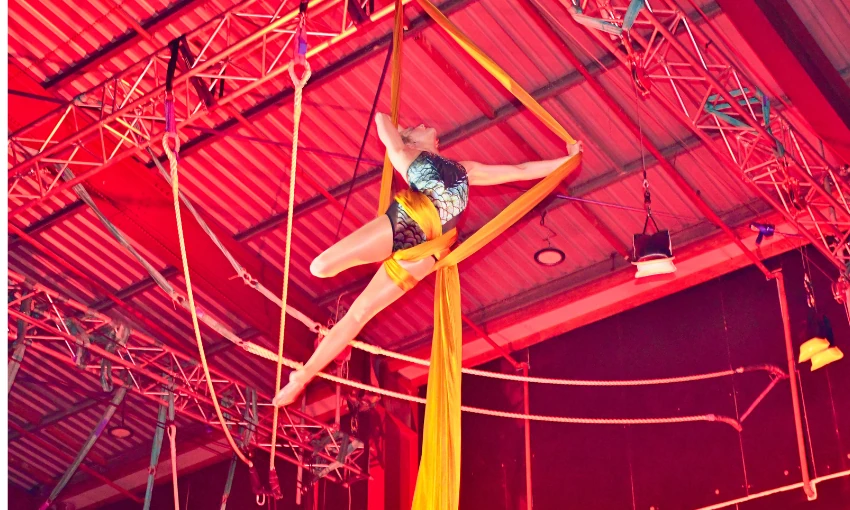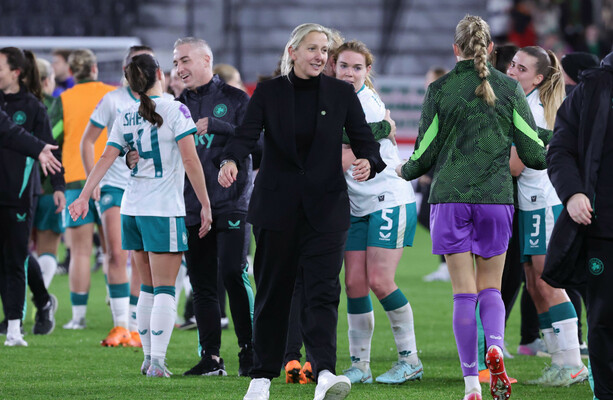Copyright thespinoff

Amid shrinking arts funding, a Wellington circus school has managed to last two decades. Sammy Carter explores how they pulled it off. I can’t seem to find the entrance. There’s no red and white striped tent with carnival music spilling out. No ringmaster in a tailcoat clicking his feet, gesturing for me to come inside. I don’t smell popcorn. And the lion from the Wellington Zoo isn’t here to jump through hoops. Instead, I follow the crowd inside Te Whaea National Dance and Drama Centre. I find a simple gym with corkboard floors, tables set with white cloth, and a programme of speeches and performances sitting on top. The stage is a black mat that contrasts with a huge metal rig hanging from the ceiling. My attention is pulled towards a wall in the back corner covered in dozens of show posters, like the green room of a community theatre. The cheesy blu-tacked posters show some faces in the room now, dressed in their best, or waiting backstage in costume. What shocks me is that some of them were actually paid to be in these shows. In a room of sparkly dresses and velvet blazers, I’m out of place dressed in all black. Getting ready, I just wanted to look professional. But perhaps subconsciously, I thought I was attending an early funeral. Because I can’t help but question: How on earth does a charity circus company stay alive for 20 years? The Circus Hub, operating under The Circus Trust, started in 2005 and sees an average of 800 students come through the doors each year – making it the biggest circus school in Aotearoa. With 15 paid trainers teaching skills like tightrope walking, aerial, trapeze, and contortion, students have gone on to be international performers. Some, you can catch dangling from the ceiling and walking on stilts at the annual World of Wearable Arts show, CubaDupa, or Newtown Festival. Now operating out of Te Whaea, the hub teaches classes aimed at everyone from toddlers to the elderly. No flexibility required. The event held in September to celebrate 20 years is a rarity. Arts in New Zealand usually don’t survive past their prime, the lights fading out with not enough profit or funding grants. Last year, the government slashed funding to the arts by $42 million. Just down the hill from the circus school in Wellington City, the Te Auaha performing arts school is on its way out after just eight years. And this month, the government announced Art History to be cut from school curricula, with leading galleries pushing back. So really, organisations like a circus school only have one way to start – as passion projects. While the women who started the hub reminisce about their days on silks and stilts, I interrupt to ask about how they beat the odds. They all excitedly talk over one another, trying to remember it all, each with a different recount. I decide to trust Eileen McNaughton, the Circus Trust’s original treasurer. She says the Hub started in 2005 with $5000 in donations and no space. At the time, circus training was growing popular overseas, and it needed a place to flourish in Aotearoa. They spent what money they had on equipment like mats and ropes, and trained wherever they could, from the Miramar Gun Club, to church halls, to the Aro Valley Community Centre, and sometimes at Te Whaea on an hourly rate. In 2009, the opportunity came up to lease part of Te Whaea, but it would cost them $80,000. McNaughton says they had to “call in every favour in the world” to make it work. After presenting a business case to Te Whaea, management agreed to subsidise the lease for the first two years. But the trust still had to bring in business fast to come up with the money. Despite all the biceps and sturdy shoulders around the room, scaling up with no safety net was the biggest challenge. They brought in new teachers and new classes, just hoping the people would come – and they did. “It was the biggest leap of faith ever,” she remembers. Leaps of faith like this are seen throughout the gala night. Eight performances see students and graduates clowning, hula hooping, and trapezing. But it’s a dark and sinister performance that stands out. A thick metal chain dangles down from the ceiling rig, and under dark green lights, alumni aerialist Julia Bromley approaches ominously to perform a “never-before-seen trick”. She holds her entire body away from the chain, spinning, holding on just by her arms, while a man in a black top hat spins it round and round. Something tells me nerves don’t get to this lot easily. Greeting manager Q Walker, I ask if they are nervous for their big event. But seeing as Q is a tightrope walker, I realise this is a silly question. Q tells me their nerves wore off weeks before. Getting up to speak at the event, their life of training has paid off, as they don’t stumble once. But maybe that’s just the charm of an American accent amid a sea of Kiwi mumbles. Q fills me in on more of the Hub’s history. In 2015, it secured the contract to run polytech Whitireia’s Circus-Dance course. But it wasn’t to last; the course was cut just four years later in 2019. Offering training in specialised, niche art forms is a luxury most of our institutions can’t afford. At the time, Whitireia was on its own cutting rampage, slashing around 70 teaching jobs and 27 programmes due to declining enrolments and financial difficulties. And with this, the hub’s business silks got too slippery. “That’s the time when our charitable work started to slowly be dropped bit by bit in favour of stuff that would bring in money quickly and keep our doors open,” Q says. Q describes the circus as “scrappy”, a quality that was put to the ultimate test when the pandemic hit. For an art form where touch and connection are almost unavoidable, Covid restrictions meant the hub had to stop classes and cut the head trainer role. Even when classes could come back, the money for charitable work just wasn’t there. Q doesn’t want tuition to be the entire business model: “If class fees are the only thing keeping us operational, we are only serving people who can pay to be here, and that doesn’t sit right with me.” But these business ethics had to wait till after the pandemic, when the hub could access council grants, donations, and hire out its space. The hub is a recipient of the council’s $25,000 Arts and Culture Annual Stability Fund. And earlier this year, an anonymous benefactor offered them $10,000 – on the condition that they find a way to double it. After a successful donation-matching campaign, they were able to go back to their roots in charitable work. This summer, free performances of the Rucksack Circus will be coming to stages in the greater Wellington region, visiting places like nursing homes, hospitals, and after-school programmes. Free workshops for dance students in Levin and Horowhenua are also in the works. “We do that without being paid for it because we believe that circus has so much value to people’s mental wellbeing, physical wellbeing, their development, and their self-belief,” Q says. I see this in the gala performances, particularly the youth circus group. Eight of them hit the stage in red and yellow leotard frocks. They take care of each other; hair is flicked out of the way so shoulders can be stood on. The tweenagers flip, skip, and roll from one corner to another to hit their mark in a headstand. Some will surely go on to speak at the next anniversary in 10 years. And the hub already has a plan for what they want it to look like. Over the next decade, the trust’s leaders want to expand career pathways for students, increase charity programmes around the capital, and raise Aotearoa’s profile in the global circus scene. And by 2034, they hope to cut the ribbon on the hub’s next venture: The Aotearoa School of Circus. With no red and white tent, no popcorn and no lion, showmanship is not the priority for this circus. It’s community. From an audience member picking up balls for a searching juggler, to telling me to turn my camera flash off so the performers can focus. It’s taken a circus of people to keep the place alive. Like Jenny Ritchie, also known as “Spinning Jenny”, who took a break from directing aerial at WOW rehearsals to attend the gala. Six of her circus artists in this year’s WOW show had training from the hub. Across the room is the volunteer accountant, a volunteer marketing manager, and a proud dad watching his daughter and wife perform. As the night ends, the performers return to the stage to take their final bow, setting their eyes on the next decade to come. For them, and everyone else in the room, that “passion project” approach is still very much alive, and it’s keeping the business kicking. Q smiles, “We’re really proud that we’re still open despite it all.”



